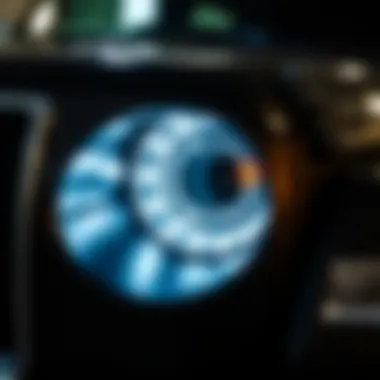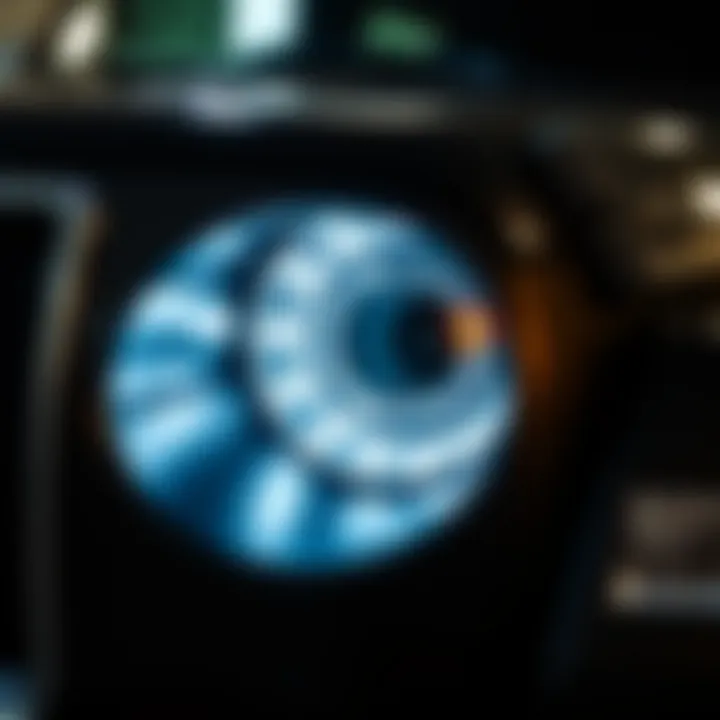Exploring the Advancements in Jeep LED Headlights


Intro
The advent of LED headlights has considerably transformed the realm of automotive lighting, particularly for Jeep enthusiasts. Gone are the days of merely relying on standard halogen bulbs and their limited visibility. Today, more and more Jeep owners are recognizing the advantages that LED technology brings, offering not only practicality but also a significant aesthetic upgrade. In this ever-evolving landscape, understanding the nuances of LED headlights for Jeep vehicles is vital for anyone looking to improve their driving experience.
This comprehensive exploration dives deep into the technical advancements, benefits of installation, and a side-by-side comparison against traditional lighting systems. With a focus on performance and style, this article offers valuable insights into selecting the right LED headlights, ensuring durability, maintenance, and understanding the unique features that these lights can bring to a Jeep. Besides, whether you are a long-time off-roader or a casual driver, the proper knowledge of LED headlights can elevate your vehicle both functionally and visually.
Let's embark on this enlightening journey to discover the many ways LED headlights are aiding Jeep owners in transforming their vehicles into beacons of adventure and safety.
Understanding LED Technology
In the realm of modern automotive lighting, a solid grasp of LED technology can dramatically shape a vehicle owner’s experience—especially for Jeep enthusiasts. As Jeep owners know, lighting is not just about illumination; it speaks volumes about style, safety, and overall performance. Understanding the intricacies of LED technology provides insight into why these lights have become so pivotal in enhancing driving experiences.
When considering vehicle upgrades, it's crucial to recognize the leap from traditional halogen bulbs to LED configurations. The topic merits attention due to its several layers of benefits, including energy efficiency, longevity, and superior performance. Knowing the science behind how LED bulbs function allows for a more informed decision when upgrading headlights, ensuring that choices lead to optimal results in visibility and style.
What are LEDs?
LED stands for Light Emitting Diode, a technology that’s revolutionized how we light our world. Unlike conventional incandescent bulbs that generate light through heat, LEDs emit light via a semiconductor. When an electric current passes through the diode, it excites the atoms, causing them to release energy in the form of photons—essentially creating light.
This shift in how light is produced offers numerous advantages. For instance, LED headlights can achieve a brightness akin to traditional lights while consuming significantly less power. So, for Jeep owners who often traverse rugged terrains, the ability to have bright and efficient lighting without draining the vehicle's battery is invaluable.
The Science Behind LED Lighting
Delving deeper into the science, LEDs utilize a phenomenon known as electroluminescence. Essentially, this process occurs when a material emits light in response to an electric current or a strong electric field.
- Durability and Robustness: The construction of LED lights contributes to their effectiveness. They are often encased in sturdy materials that can withstand harsh environments, making them ideal for off-road adventures where durability is a must.
- Heat Management: One aspect that often goes unnoticed is thermal management. LEDs produce less heat compared to halogen lamps, which not only extends their lifespan but also reduces the risk of damage to surrounding components of the Jeep.
- Color Spectrum: The light emitted by LEDs tends to have a higher color temperature, often approaching daylight levels. This results in better visibility and reduces eye strain during nighttime driving— an essential factor for ensuring safe navigation through the night.
"Understanding LED technology is not just about knowing how they work; it’s about appreciating how they redefined automotive lighting, enhancing both functionality and style."
Advantages of LED Headlights
When it comes to upgrading Jeep headlights, the shift to LED technology is not merely a trend but a wise investment. The advantages are not only tangible but transform the driving experience altogether. Understanding these benefits is crucial for anyone looking to enhance their vehicle’s safety and aesthetics. Let's break down the three primary advantages: longevity and durability, energy efficiency, and improved visibility.
Longevity and Durability
One of the standout features of LED headlights is their impressive lifecycle. Unlike traditional halogen bulbs, which may flicker out after a couple thousand hours, quality LED systems can last anywhere from 20,000 to 50,000 hours. This means less frequent replacements and the peace of mind that comes with it. The materials used in LEDs generally boast better resilience against shocks, temperature variations, and moisture, making them perfect for off-roading adventures. Jeep drivers often face rugged terrain and sporadic weather, so having headlights that can take a beating without burning out is a significant advantage.
"Investing in LED headlights is not just about brightness; it's about reliability on the road."
This durability is often reflected in cost savings as well. Fewer replacements translate to lower upkeep expenses over time, giving you more room in your budget for other upgrades or adventures.
Energy Efficiency
Energy efficiency is an important consideration in today’s automotive landscape. LED headlights consume significantly less power compared to halogen counterparts—often up to 80% less. This efficiency not only reduces the load on your Jeep’s electrical system but also translates into longer battery life and enhanced fuel economy. For a vehicle routinely used in off-road conditions, where every bit of battery power can make a difference, these benefits are vital.
Moreover, because LEDs generate less heat than traditional bulbs, there’s less strain on the vehicle's cooling system. This is an often-overlooked aspect, but avoiding excessive heat can help maintain not just the headlights, but also other components of the vehicle in the long run.
Improved Visibility
When safety takes precedence, visibility is non-negotiable. LED headlights excel in providing brighter and more focused light beams. The light produced by LEDs is not only crisper but also more closely resembles natural daylight, enhancing depth perception on the road. This feature is invaluable during nighttime and inclement weather, situations where Jeeps often find themselves not just navigating through everyday streets but taking on challenging backcountry routes.
The pattern of light produced by LED systems also provides a wider viewing angle, illuminating more of the roadside and thus reducing blind spots. This serves to heighten awareness of other vehicles, pedestrians, and obstacles—elements that can make or break a safe driving experience.
Types of LED Headlights for Jeeps
The world of Jeep LED headlights is as diverse as the vehicles themselves. Types of LED headlights can significantly impact both performance and aesthetics, making it essential for Jeep owners and enthusiasts to understand their options. Selecting the right type of headlight can enhance the driving experience, improve safety, and even elevate the overall look of the vehicle. Here, we break down the key categories and what each one offers, ensuring that readers grasp the advantages and considerations involved in their choices.


Factory Replacement LED Headlights
Factory replacement LED headlights are designed to fit directly into the existing headlight assembly of your Jeep, providing a seamless upgrade process. These headlights typically adhere to original equipment manufacturer (OEM) specifications, meaning they are built to the same standards as the ones that came with your Jeep. This ensures a fitting experience that’s smoother than butter on hot toast.
One of the biggest advantages of factory replacements is compatibility. Since they’re designed specifically for your model, there’s little worry about wiring issues or complicated installations. It’s as simple as popping out the old bulbs and slipping in the new ones. What’s more, these headlights often retain the same beam pattern as stock, ensuring that visibility remains unaffected while delivering improved brightness and efficiency.
Moreover, opting for factory replacements tends to offer better warranty support. Many manufacturers stand by their products, providing coverage for a certain period. In the long run, it’s both a practical and prudent choice for those who simply want an upgrade without the fuss.
Aftermarket Options
Shifting gears to aftermarket options, the variety available can bewilder even the savviest of Jeep aficionados. These headlights are made by third-party manufacturers and can offer various advantages over factory replacements, particularly in terms of aesthetics and performance.
From different light colors to unique housing designs, aftermarket options allow for personal expression. For example, a Jeep owner might choose a rugged, off-road style headlight that complements the adventurous spirit of their vehicle. More importantly, many aftermarket LED headlights come equipped with advanced technology—like adaptive lighting—which can automatically adjust the beam's focus based on the vehicle's speed.
However, it’s crucial to tread carefully when opting for these headlights. Not all aftermarket products meet stringent safety and performance standards. That's why consumers need to check reviews, ratings, and even pay attention to the seller’s reputation. After all, nobody wants to end up with headlights that light up more like a candle than a beacon.
Customizable LED Solutions
Customization is where creativity meets functionality, and customizable LED solutions offer a tempting buffet for Jeep owners looking to tailor their vehicle’s lighting to their preferences. These headlights allow modifications in brightness levels, color temperatures, and even stylish accents that can sync with other vehicle lighting systems.
For the more tech-savvy crowd, some customizable options come with smartphone connectivity features. Users can adjust their headlights via an app, changing color and brightness based on personal mood or driving conditions, bringing a touch of personal flair to the trip. The flexibility in usage makes these solutions particularly appealing for those who often venture into various terrains and conditions.
Yet, with great power comes great responsibility. Customizing headlights can sometimes raise compliance issues with local regulations, so it's advisable to check the rules before diving in head first. Despite these potential pitfalls, the thrill of crafting a unique look often outweighs the concerns for many Jeep enthusiasts.
Installation Processes
Installing LED headlights in your Jeep is not just a simple swap-out; it's a critical step that can have a significant impact on your overall driving experience. This process ensures that you get the most out of the advanced lighting technology by utilizing its full potential. A well-installed set of LED headlights enhances visibility during nighttime drives and in adverse weather conditions. It's important to understand that proper installation can also prolong the life of the lights while ensuring compliance with road safety regulations.
Preparing for Installation
Before jumping right into the installation, it’s crucial to prepare adequately. This means gathering the right tools and materials beforehand. You will usually need basic tools like screwdrivers, wrenches, and perhaps a socket set. It’s also wise to have your Jeep’s manual handy, as it will provide specific details about your model.
Here are some key steps to prepare for your installation:
- Check Compatibility: Ensure the LED headlights you have purchased are compatible with your Jeep make and model. Not every LED headlight fits every Jeep.
- Gather Tools: As mentioned, gather the necessary tools to avoid last-minute scrambles.
- Work Environment: Choose a location with good lighting and space to work. An outdoor area or well-lit garage works best.
- Safety Gear: Consider wearing gloves to protect your hands from sharp edges and a pair of safety glasses to shield your eyes from debris.
Step-by-Step Installation Guide
When you're ready to get started, follow these detailed steps to install your LED headlights efficiently:
- Disconnect the Battery: Safety first! Make sure to disconnect the negative terminal of the battery before touching any wiring.
- Remove the Grille: Depending on your Jeep model, you may need to remove the grille or cover to access the headlights. Look for screws or clips that hold it in place.
- Take Out the Old Bulbs: Carefully unplug the old halogen bulbs from their connectors. You might need to twist or pull them out gently.
- Install the LED Headlights: Insert your new LED bulbs into the same socket where the halogens were. Ensure they're fitted securely and the connectors snap in place as needed.
- Test the Lights: Before reassembling everything, reconnect the battery and switch on your headlights to check if they work. Adjust as necessary.
- Reassemble: If everything works well, go ahead and put the grille or cover back. Make sure all screws and clips are firmly secured.
- Final Checks: Turn on the headlights again to ensure they're functioning as intended.
Common Installation Challenges
Even with preparation and a step-by-step guide, challenges can arise during installation. Here are some common hiccups and how to sidestep them:
- Compatibility Issues: Double-check your headlights once more if there’s a fitment problem. If needed, reach out to the manufacturer for compatibility details.
- Wiring Problems: If the setup doesn’t light up, ensure you’ve connected everything properly. Sometimes, connectors don’t snap like they should, or they can be reversed.
- Heat Dissipation: Some LED models have heat sinks that need proper clearance or airflow. Make sure these aren’t blocked once installed, as overheating can reduce efficiency.
- Legal Compliance: Make certain that the LED headlights you chose comply with local laws. Some regions have specific regulations regarding the color and brightness of headlights.
A well-executed installation can transform not just the look of your Jeep, but significantly enhance your safety and visibility on the road.
By arming yourself with knowledge and preparing beforehand, you can ensure a smooth installation process while avoiding unnecessary headaches.
Comparing LED and Halogen Headlights
When it comes to automotive lighting, understanding the difference between LED and halogen headlights is of paramount importance. As technology advances, so do the options available to Jeep owners who wish to upgrade their vehicle's illumination. This section aims to provide a clear comparison between these two types of headlights, highlighting their distinct performance characteristics, financial implications, and user experiences, allowing you to make an informed decision tailored to your driving needs.
Performance Metrics


Performance is certainly the key aspect when evaluating headlights. LEDs, or Light Emitting Diodes, typically outperform traditional halogen lights in multiple areas. For instance, LED headlights emit a brighter and whiter light that substantially improves visibility, especially in night-time or adverse weather conditions. The increased luminescence means better distance perception, which is particularly important for off-road Jeep enthusiasts navigating through varied terrains.
- Brightness: LEDs can shine up to 300% brighter than halogens, achieving higher lumens output and reaching a longer range without causing glare for oncoming drivers.
- Heat Dissipation: Halogen bulbs generate considerable heat during operation, which can lead to burn-out and shorten their lifespan. In contrast, LEDs operate cooler and can last up to 25 times longer.
"Replacing halogen bulbs with LED headlights can transform your nighttime driving experience, providing clarity that leads to safety."
Cost Analysis
When it boils down to cost, there’s more than meets the eye. While halogen headlights typically cost less upfront, they may not be the economical choice in the long run. Standard halogen bulbs range from $15 to $50, while high-quality LED headlight models can run between $100 and $300. However, consider the total cost of ownership:
- Replacement Frequency: Halogen bulbs commonly last about 500 to 1,000 hours, requiring frequent replacements, while LEDs can last anywhere from 15,000 to 30,000 hours, minimizing long-term expenses.
- Energy Efficiency: LEDs consume far less energy, drawing about 25-30% less power than halogen bulbs, which translates to savings on your fuel efficiency.
Therefore, investing in LED headlights may lead to savings in both replacement costs and fuel consumption, making them a financially wise choice in the long term.
User Experience
User experience doesn’t just boil down to brightness or costs; it encompasses how one feels while driving. Jeep owners often discuss the transformative experience of switching from halogens to LEDs:
- Aesthetic Appeal: Many owners appreciate that LEDs can enhance the overall look of their vehicles, providing a modern edge that complements the rugged Jeep style.
- Better Visibility: Drivers often report feeling more secure at night with LEDs, noting how much easier it is to see road signs and potential hazards.
The feedback from the Jeep community emphasizes that upgrading to LED headlights significantly elevates the driving experience, offering both functional and visual improvements. As such, the choice between LED and halogen headlights is often clear, especially for those who value both performance and aesthetics in their vehicles.
Choosing the Right LED Headlight
Choosing the right LED headlights for your Jeep is not just about aesthetics; it plays a crucial role in your driving safety and overall vehicle performance. With the wide array of options available today, understanding which features truly matter becomes essential. Selecting the right headlights can enhance night visibility, improve energy efficiency, and add a personal touch to your vehicle’s look.
When shopping for LED headlights, keep in mind what you need based on your driving habits. Are you an off-road warrior navigating dusty trails or a city slicker maneuvering through urban landscapes? Your choice of headlights should reflect your unique driving conditions and style.
Key Features to Consider
When evaluating LED headlights, several features should be front and center:
- Brightness or Lumen Output: This refers to how much light the headlights emit. A brighter light can make a world of difference when driving at night.
- Color Temperature: The color temperature affects visibility and can range from warm yellow light to cool white light. Typically, a temperature around 6000K provides a more daylight-like effect, which many find preferable for driving.
- Beam Pattern: The design of the beam pattern can either illuminate the road effectively or create blind spots. Look for headlights that offer a well-distributed beam.
- Durability and Weather Resistance: Jeep adventures can expose headlights to rough conditions. Ensuring your lights are rated for water and dust resistance can prolong their lifespan.
- Ease of Installation: Some LED headlights can be a bit tricky to install. Depending on your comfort level with vehicle maintenance, look for models known for easy installation or plug-and-play options.
- Regulatory Compliance: Check if the product meets the local vehicular lighting standards. Certain state regulations mandate specific brightness levels or beam patterns.
Incorporating these factors in your decision-making allows you to choose headlights that not only meet your aesthetic desires but also cater to your safety needs.
Brands Worth Noting
Choosing quality brands can be just as impactful as selecting the right features. Here are a few noteworthy brands that stand out in the LED headlight market for Jeeps:
- JW Speaker: Known for their premium quality and advanced lighting technology, they deliver high-performance headlights that excel in various conditions.
- Vision X: Their rugged designs paired with superior brightness make them a popular choice among off-road enthusiasts.
- HEISE LED: Offering a great balance between performance and price, HEISE is known for its reliable products tailored for Jeep lovers.
- Rugged Ridge: This brand is often trusted by Jeep owners as they focus on both functionality and style in their headlight assemblies.
- Oracle Lighting: A bit on the pricier side, but Oracle guarantees innovation, especially with their customizable options.
When investing in LED headlights, don’t skip the research stage. Reading user reviews, comparing products, and even checking discussions on sites like Reddit can provide insightful perspectives as you finalize your decision.
Ultimately, the right choice can drastically improve your driving experience, offering you peace of mind while navigating through any terrain.
Maintenance of LED Headlights
Caring for your LED headlights isn’t just a footnote in the manual; it’s a vital piece of preserving performance and ensuring safety on the road. While LED technology generally brings a longer lifespan compared to traditional halogen options, neglecting maintenance can lead to diminishing returns. Keeping your headlights in top shape not only enhances aesthetic appeal but also optimizes visibility during nighttime excursions or inclement weather.
Regular maintenance of LED headlights involves routine checks and specific care practices that help ensure their longevity and effective operation. LED headlights can outlast their predecessors by years, but even the most sophisticated technology needs a little TLC.
Routine Checks and Care
A little prevention can go a long way when it comes to vehicle maintenance, and that includes your Jeep’s LED headlights. Here are some key areas to focus on for routine checks:
- Visual Inspection: Take a moment to peer at your headlights regularly. Look for any signs of condensation or discoloration.
- Cleaning: Dirt and grime can accumulate over time, dimming the brightness of your lights. Use a gentle cleaning solution and a soft cloth to avoid scratches. This simple act can improve light output dramatically.
- Check for Flickering: If you notice any flicker when you turn on your headlights, it can indicate a problem with the wiring or the LED bulb itself. Spotting this early can save you from larger issues down the line.


By integrating these checks into your routine, you proactively maintain your Jeep's performance, avoiding problematic surprises during your adventures.
Troubleshooting Common Issues
Despite best efforts, issues can arise with your LED headlights. Understanding some common problems can facilitate quick solutions:
- Dim Lights: If your headlights appear dim, it might be due to a poor electrical connection or dirt build-up. In such cases, clean the light covers first and check the connections.
- Inconsistent Light Output: This might signal a failing LED driver or issues with the wiring. Make sure to inspect connections and if necessary, seek professional assistance.
- Sudden Failure: If one light goes out suddenly, it’s often a singular issue with that bulb. However, if both fail, it may indicate a larger electrical issue.
"Keeping your headlights in peak condition isn't just for looks; it's a safety issue that directly impacts your visibility on the road."
By promptly addressing these issues, you ensure their optimal performance, thus enhancing the overall driving experience of your Jeep. Armed with this knowledge, you can take the reins in preserving your LED headlights, keeping them shining bright as you traverse the great outdoors.
For more information on vehicle lighting regulations, you can visit NHTSA or check for local state regulations that may affect LED installations.
Legal and Regulatory Considerations
When it comes to upgrading your Jeep with LED headlights, understanding the legal and regulatory considerations is paramount. Not only does this ensure your vehicle remains roadworthy, but it also protects you from potential fines or penalties that can stem from non-compliance. Various jurisdictions impose regulations to ensure vehicle lighting meets safety standards, and failing to abide by these can lead to a hassle down the line.
"Regulations regarding vehicle lighting are not mere suggestions; they’re the law of the land and must be navigated carefully to avoid pitfalls."
Compliance with existing automotive standards is a crucial part of this topic. The headlights must meet specific brightness levels, color temperature standards, and beam patterns as established by governing bodies. This keeps everyone safe on the road by preventing blinding glare to oncoming drivers while ensuring maximum visibility in various conditions. Furthermore, understanding these regulations helps streamline the installation process, as LED replacements must fit within designated specifications set forth by automotive safety authorities.
Compliance with Automotive Standards
Automotive standards vary between regions and are designed to ensure that lighting solutions provide adequate visibility without compromising safety. For instance, in the United States, the Department of Transportation (DOT) establishes several regulations that LED headlights need to comply with. One important measure is the Federal Motor Vehicle Safety Standard (FMVSS) No. 108, which pertains to lamps, reflective devices, and associated equipment.
- Brightness Levels: LED headlights must maintain a specific lumen output to be deemed compliant. Too bright, and they could dazzle oncoming traffic; too dim, and they won't adequately illuminate the road ahead.
- Color Temperature: Different regions may have varying regulations regarding the color temperature of headlights. Most jurisdictions restrict headlights to a color temperature of 6000K or below.
- Beam Pattern: The beam patterns produced by your new LED headlights should not cause excessive glare. Adaptive technologies that adjust beam angles can help in achieving compliance.
Ensuring your Jeep's LED headlights adhere to these standards will not only spare you headaches but also enhance safety for both you and other road users.
State-Specific Regulations
State regulations present another layer of complexity that Jeep owners need to navigate when upgrading their headlights. Depending on where you live, you could face different rules that dictate what modifications you can make to your vehicle's lighting system. For example:
- California: The state imposes quite strict regulations on aftermarket lighting, particularly around colors that mimic emergency vehicles.
- Florida: Here, some counties have additional restrictions on headlight modifications, adding another element for Jeep owners to consider.
- Texas: While more lenient compared to other states, Texas still has guidelines regarding height and brightness of the headlights.
Since local regulations can differ not only state by state, but even county by county, it’s advisable for Jeep owners to do their due diligence. Checking local laws can save valuable time and money by ensuring that your setup adheres to specific requirements.
Keeping your legal and regulatory ducks in a row when installing LED headlights is a step that cannot be overlooked. It allows you to enjoy enhanced visibility and aesthetic appeal without running into unintended legal troubles.
Future of LED Headlight Technology
The future of LED headlight technology is more than just a conversation about bright lights. It's about the shift in how we see and interact with the road, especially for Jeep enthusiasts. With continual advancements in this realm, it's vital to understand how these innovations redefine both functionality and style. From improvements in energy efficiency to extensive customization options, the trajectory of LED technology is about enhancing user experience while keeping in mind environmental sustainability. In the coming years, these headlights will likely not only improve visibility but will also serve as personal expressions for vehicle owners.
Innovations on the Horizon
In the not-so-distant future, several innovations are poised to reshape the landscape of LED headlights for Jeeps.
- Adaptive Lighting Systems: Imagine headlights that adjust their beams based on speed and road conditions. This innovation increases safety by optimizing visibility, particularly during night drives or tough terrain.
- Smart Connectivity: Linked to your Jeep’s onboard platform, smart LEDs could adjust settings automatically by receiving data on weather conditions or terrain type. No more fumbling with switches — just drive and let the technology do the thinking.
- OLED Integration: Organic Light Emitting Diodes (OLED) are making waves with their thinness and flexibility. Future Jeep headlights might incorporate OLED for enhanced design flexibility, allowing for unique light patterns and greater aesthetic appeal.
- Enhanced Durability Materials: The future may also see the use of advanced polymers or materials, making headlights more resistant to impacts and weather, ensuring a longer lifespan and consistent performance on rugged trails.
The fusion of these technologies promises to bring about significant changes, ensuring every Jeep can adapt to the driver’s specific needs and challenges.
Impact on Automotive Design
The advancements in LED headlight technology are also significantly influencing the design of Jeep vehicles. The shift to sleeker, more compact lights allows for increased design freedom. Traditional headlight designs often dictated the vehicle's overall aesthetic; however, with LEDs, manufacturers can experiment with various shapes and placements.
- Streamlined Aerodynamics: Smaller and more efficient headlights contribute to overall vehicle aerodynamics, impacting fuel efficiency and performance.
- Integration with Design Elements: The modern Jeep can integrate headlights with other features like grilles and bumpers, creating a more cohesive look.
- Personalization Options: LED technology allows for customizable lighting options, enabling Jeep owners to select colors and patterns that reflect their unique styles.
This evolution in design isn't just about looks; it also influences how Jeep models appeal to a tech-savvy generation that prioritizes aesthetics alongside practicality. As this technology continues to evolve, one can expect the lines between function and form to blur even further, leading to exciting possibilities in Jeep design.
"Innovation is the key to improving both the functionality and the visual appeal of modern vehicles."
By keeping oneself informed about lighting technology trends, one can make better choices for their vehicles, enhancing both performance and design while ensuring they are on the cutting edge of automotive advancements.















